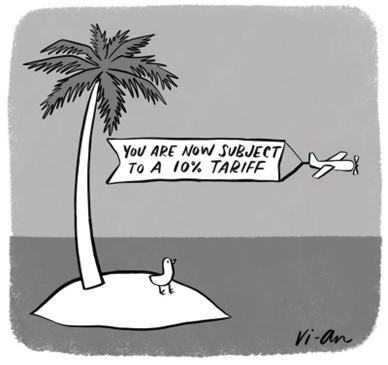Investor Update: U.S. Tariffs and Global Trade Tensions
Written by President, Jamie Murray, CFA.
Yesterday, the Trump Administration enacted an executive order imposing tariffs ranging from 10% to 54% on imports from most countries. Canada and Mexico were spared in this latest round, continuing to trade tariff-free under USMCA for most goods — though steel and aluminum remain exceptions. Equity markets responded sharply, posting their worst single-day performance since the early days of the COVID-19 pandemic. In light of this, we wanted to share our perspective with investors.
Early signs suggest a chaotic rollout. Similar to the “Canada 51st State” rhetoric (which has since been toned down), we believe the U.S. administration is taking an extreme stance to attempt to create confusion and foster a better deal for the country. Time will tell if this is correct. The administration’s methodology for determining “reciprocal tariffs,” which included countries inhabited only by penguins, suggests a hasty and poorly executed process. We believe cooler heads will ultimately prevail. While the headline tariffs are steep, the final rates implemented — if they stick— will likely be more measured to avoid choking off economic activity. As well, the United States likely does not want to push its remaining allies in Asia closer to China. (Note as of writing, there were headlines about Vietnam angling for a deal, leading to a surge in retail apparel stocks).

Source: William Blair & Company
If the tariffs outlined in the executive order, or anything close to them, remain in place, certain sectors — particularly those with global supply chains — will face a difficult transition. U.S. companies are already responding: Stellantis (Chrysler) has announced temporary layoffs in Michigan and Ohio, while Whirlpool has cut jobs in Iowa. In addition, firms contemplating U.S. investment may now be reconsidering.
Perhaps most confusing is the rationale for reshoring manufacturing sectors like textiles and autos. America’s greatest exports — technology, innovation, and those considered cultural influence — are considered in the service category rather than in traditional trading statistics on goods. iPhones, Nike products, and Starbucks beans may be made in China, Vietnam, or Guatemala, but they’re designed, marketed, and monetized in the U.S. A tariff regime that discourages global integration risks damaging the very brands and ideas that underpin American prosperity. We’re already seeing early signs of this in Canada, where there is a notable shift in how consumers view U.S. brands.
We believe our portfolio is resilient to short term shocks and provides necessary goods and services required for economic progress. As always, we remain committed to our long-term investment process, which has worked through numerous economic cycles, by focusing on company fundamentals, competitive advantages, and long-term value creation. Periods of disruption often reveal compelling opportunities that we are able to take advantage of.
As always, we thank you for your continued trust.

